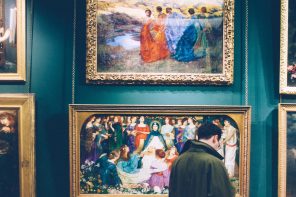Editor’s Note: This is the fourth and final installment of a series by Jim McCullough that will look at the ways in which art contributes to faith. Please be sure to read parts one, two and three.
How does art contribute to faith?
For David Brown, emeritus professor at the Institute for Theology, Art and Imagination, it does so in three distinct yet inter-related ways. First, Brown contends that the experience of faith as well as the content of faith are shaped in an on-going dialectic between revelation and culture – of which the arts are an integral part – resulting in what Brown refers to as “tradition.” As the primary conduit for the Christian Faith, which shapes the experience of faith, tradition for Brown involves an often changing and ever expanding comprehension of the “faith once delivered to the saints.” Brown cites many examples, one of which is the meaning of Christmas. So much of the Christmas tradition as we now receive it – the hymns, the pageants, the nativity programs – focuses on Christ’s experience of childhood and on the subject of childhood in general. Whether that was the original intention of the Gospel writers is a question Brown explores. It would seem that those writers were far more concerned with how the events of Christ’s birth and early life point toward His divinity and the path of His life toward the Passion. But a thousand years of paintings, Christmas oratorios and church Nativity sets, beginning especially since St Francis first “performed” the Nativity with what we now call a creche, have profoundly and unalterably shaped the way Christians read the Gospels and ascribe meaning to them. This heightened awareness of childhood has, of course, shaped Western society toward a greater appreciation for and concern about children.[1] Think of Charles Dickens’ A Christmas Carol, a story that transmutes Christian themes into a Victorian context sprinkled with liberal concern for child welfare and the working conditions of the poor, and you have an enduring classic that still shapes attitudes toward the vulnerable in society.
 For Brown, that is the very kind of dialectic he sees in the development of tradition: Christian Faith adopting “secular” concepts and images, instilling them with new content and meaning, and thus being changed itself even as it then changes the society around it. This dynamic affects the way Christians experience and understand their faith, and propels new initiatives and developments in society, which in turn affects the way Christians experience and understand their faith.
For Brown, that is the very kind of dialectic he sees in the development of tradition: Christian Faith adopting “secular” concepts and images, instilling them with new content and meaning, and thus being changed itself even as it then changes the society around it. This dynamic affects the way Christians experience and understand their faith, and propels new initiatives and developments in society, which in turn affects the way Christians experience and understand their faith.
Secondly for Brown, the arts open up affective and imaginative space in the experience of faith. The epistemological significance of the emotions and imagination are one contribution of postmodern sensibility. There is nothing new, of course, in affirming how the arts touch our hearts, but to posit the affective and imaginative domains as integral aspects of our rationality, that they are legitimate means of knowledge along with the cognitive dimension, is of a more recent vintage.[2] It is one thing to know that Christ died for sins, for example. It is another, and more expansive thing, to imaginatively engage with the experience of suffering by spending time with Graham Sutherland’s portrayal of misery in his St Matthew’s Church Crucifixion (1946) or Marc Chagall’s placing of Jesus’ suffering in the context of the Jewish experience in his White Crucifixion (1938). Musical works like James MacMillan’s Seven Last Words from the Cross (1993) or Mel Gibson’s film The Passion of the Christ (2004) are further examples of art that afford opportunities for imaginative engagement with familiar themes and events which, for many, deepen an understanding both of the Biblical story as well as of human experience.
The third of Brown’s proposals involves what has become the most familiar, as well as the most controversial, in his work. For Brown, the arts and culture provide opportunities for contact with God because they impart something of the grace and presence of God to the receiver. That is, Brown proposes that meaningful aesthetic phenomenon and experiences have an inherently sacramental quality to them. In them and through them, God makes Himself available and accessible. This echoes the theology of beauty, wherein beauty serves as a means of transcendental experience (see Part 1 of this series). But Brown takes this further. He urges a move beyond the instrumental impulse of evaluating things – like church buildings or hymns or books, gardens, even sports events – toward a more intrinsic consideration. Church architecture, for example, not only facilitates worship and provides useful space, but may also actually communicate something about God, through which God makes Himself available to human experience:
In a proper sense of the sacramental, the mediation is not purely instrumental; instead the material symbol says something about God in its own right, and so it is an indispensable element in assessing both the immediate experience and any further significance it may have.[3]
The marvel of Brown’s work is the breadth of his survey of artworks and styles, and the theological analysis that he brings to bear. Whether or not one is convinced of the whole scope of his proposals, one’s appreciation for and understanding of the dynamics of art in relation to faith is immeasurably enhanced by his work.
Conclusion
The procedural order of this series is not in any way meant to suggest an ascent toward the right or better account of how art can contribute to faith. The purpose rather has been to identify what I see as four approaches to the question of how art can contribute to faith, and to alert readers to recent writings on the subject. These sources are best characterized as approaches, not schools, as none of them are institutionalized in any way. Moreover, each approach has laudable and legitimate light to shed on the relation between art and spirituality and stands to be applicable as a prism of consideration or an emphasis in a particular context. Emphasizing the ecstatic potential of beauty, for example, may serve when healing or contemplative spirituality is desired. An approach which adopts ethics as an interpretive lens highlights personal and social responsibility, and could help audiences recognize the effects of advertising and media, and how faith can be both formed and deformed. Phenomenology opens up space for people to take artworks seriously as a “kind of address” to them to which they can make a response. David Brown’s understanding of how culture and the arts contribute to the shaping of a hermeneutical tradition, and his analysis of a sacramental dynamic in art may go a long way in helping people broaden their awareness of God’s presence in all things and reconcile the frequent exclusion of the sacred from the secular. In all these instances, the arts are conceived of as ways through which people can help develop the kind of “eyes that see and ears that hear” of which the Scriptures places such priority.
[1]David Brown, Tradition and Imagination, 79-105. Brown discusses these dynamics further with particular attention to the experience of women in Discipleship and Imagination: Christian Tradition and Truth (Oxford: Oxford University Press, 2007), 19-31.
[2]Brown discusses the instrumentalization of rationality in the modern West in God and the Enchantment of Place: Reclaiming Human Experience (Oxford: Oxford University Press, 2004), 21-25. Brown is also appreciative of the Exercises of St Ignatius Loyola, who initiated a form of contemplative imagination as a spiritual discipline.
[3]Brown, God and Enchantment, 30.





